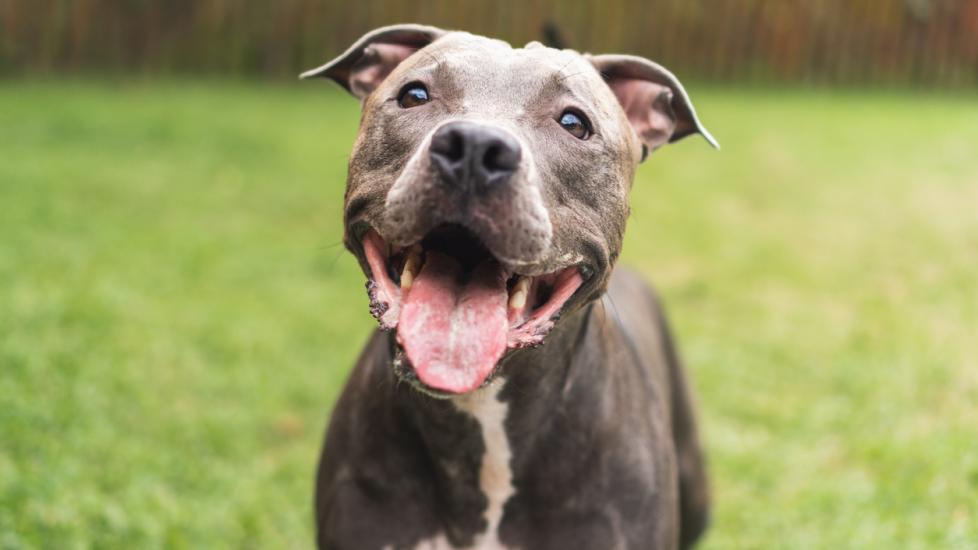American Pit Bull Terrier
Pit Bulls, also known as American Pit Bull Terriers, are a dog breed that has a controversial history and reputation. Originally bred in England for bull baiting, they were later brought to the U.S. and used in dog fighting. But despite their past, many Pit Bulls are known for their loyalty and affection toward their favorite people.
But what is a Pit Bull, exactly? It’s important to note that the Pit Bull breed isn’t recognized by any major kennel clubs. Instead, “Pit Bull” is a blanket term used to describe several breeds, including:
-
Mixes of these breeds
Dog DNA tests can help you find out if your dog is classified as a Pit Bull.
In general, Pit Bull Terriers are a medium-size dog, with males weighing 35–70 pounds and standing 18–21 inches tall. Female Pit Bulls are usually smaller, typically weighing 30–60 pounds and standing 17–20 inches tall. They have a muscular build, and short and smooth coats that come in a wide range of Pit Bull colors—including black, blue, brindle, and fawn.
Caring for a Pit Bull
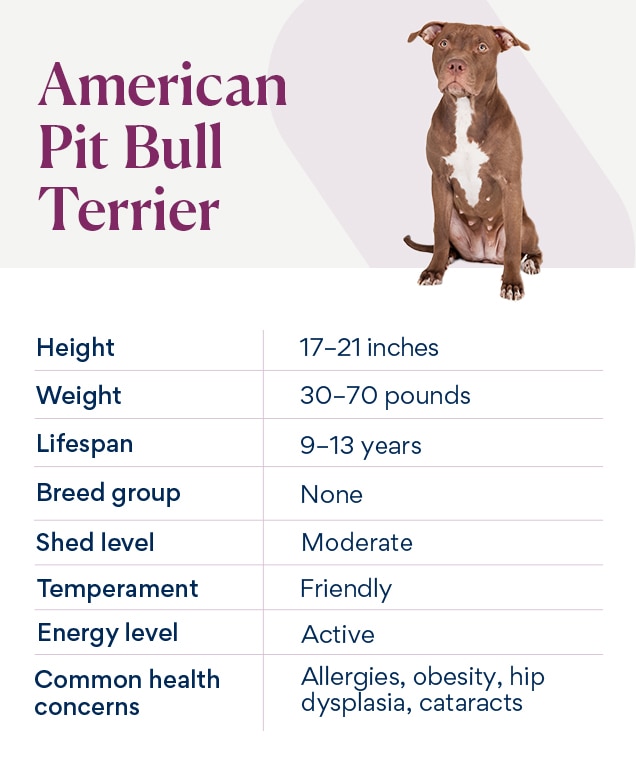
Pit Bulls are known for their loving nature, outgoing personality, and affection toward their humans. With the right socialization and training, this can make them great family pets.
While they can be strong-willed at times, they’re highly intelligent dogs and eager to please, which makes training straightforward. However, without proper training and socialization, they could become reactive in new or unfamiliar situations.
Pit Bull breeds have a high energy level and require regular exercise and playtime—usually at least 45 minutes to one hour a day. They enjoy going for walks, playing fetch, agility training, and anything that allows them to connect with their pet parent in an active way.
The Pit Bull breed isn’t recognized by any major kennel clubs. Instead, “Pit Bull” is a blanket term used to describe several breeds.
As with many intelligent and active breeds, they do best with routine and structure, and can be wonderful companions for the right person. But before bringing a Pit Bull puppy home, it is important to understand their unique needs and characteristics.
Pit Bull Health Issues
Pit Bulls, like all breeds, can be prone to certain health issues. However, they are generally considered a healthy breed.
It’s always a good idea to consider pet insurance to help cover unexpected veterinary costs. Regular veterinary checkups and preventative care, such as vaccinations and parasite control, are also necessary to maintain good health and prevent potential medical problems from developing.
Allergies
Allergies are a common health concern in Pit Bulls, as they are in many other breeds. Allergies can cause skin irritation, itching, and hair loss, and can be triggered by a variety of factors including food, flea bites, and environmental allergens such as pollen or dust mites.
Treatment for allergies in Pit Bulls typically involves identifying and avoiding the allergen, as well as using anti-inflammatory medications, shampoos, and other products to manage the symptoms. In severe cases, your veterinarian may recommend a special diet or other treatments to help manage your dog’s allergies.
As a pet parent, it’s important to be aware of the signs of allergies in your Pit Bull and to have a veterinarian evaluate them if allergies are suspected. With proper management, many dogs with allergies can lead a comfortable and healthy life. However, some dogs may require ongoing care and treatment to manage their symptoms.
Hip Dysplasia
Hip dysplasia, another common health concern in Pit Bulls, is a genetic condition that affects the hip joint due to abnormal development. This can lead to arthritis and pain. The symptoms of hip dysplasia can vary and may include lameness in the hind legs, difficulty rising or jumping, and a noticeable change in activity level.
Treatment for hip dysplasia typically involves managing the pain and inflammation associated with the condition, as well as keeping your dog at a healthy weight to reduce stress on the joints. In severe cases, surgery may be necessary to correct the hip joint and improve mobility.
Hip dysplasia can be a progressive and degenerative condition, and some dogs may require ongoing care to manage their symptoms.
Cataracts
Cataracts are an eye condition commonly found in many dog breeds, including the Pit Bull Terrier. Cataracts are cloudy or opaque areas in the lens of the eye that can cause vision loss and, eventually, complete blindness. The symptoms of cataracts can vary and may include cloudy or hazy vision, sensitivity to light, and a noticeable change in behavior such as bumping into objects or seeming disoriented.
Treatment typically involves surgery to remove and replace the lens. This procedure, known as cataract surgery, is typically performed by a veterinary ophthalmologist and can restore vision in most dogs.
Obesity
Pit Bulls are prone to obesity, which can lead to a number of health problems. Maintaining a healthy weight through a balanced diet and regular exercise is important to keep them healthy.
What To Feed a Pit Bull
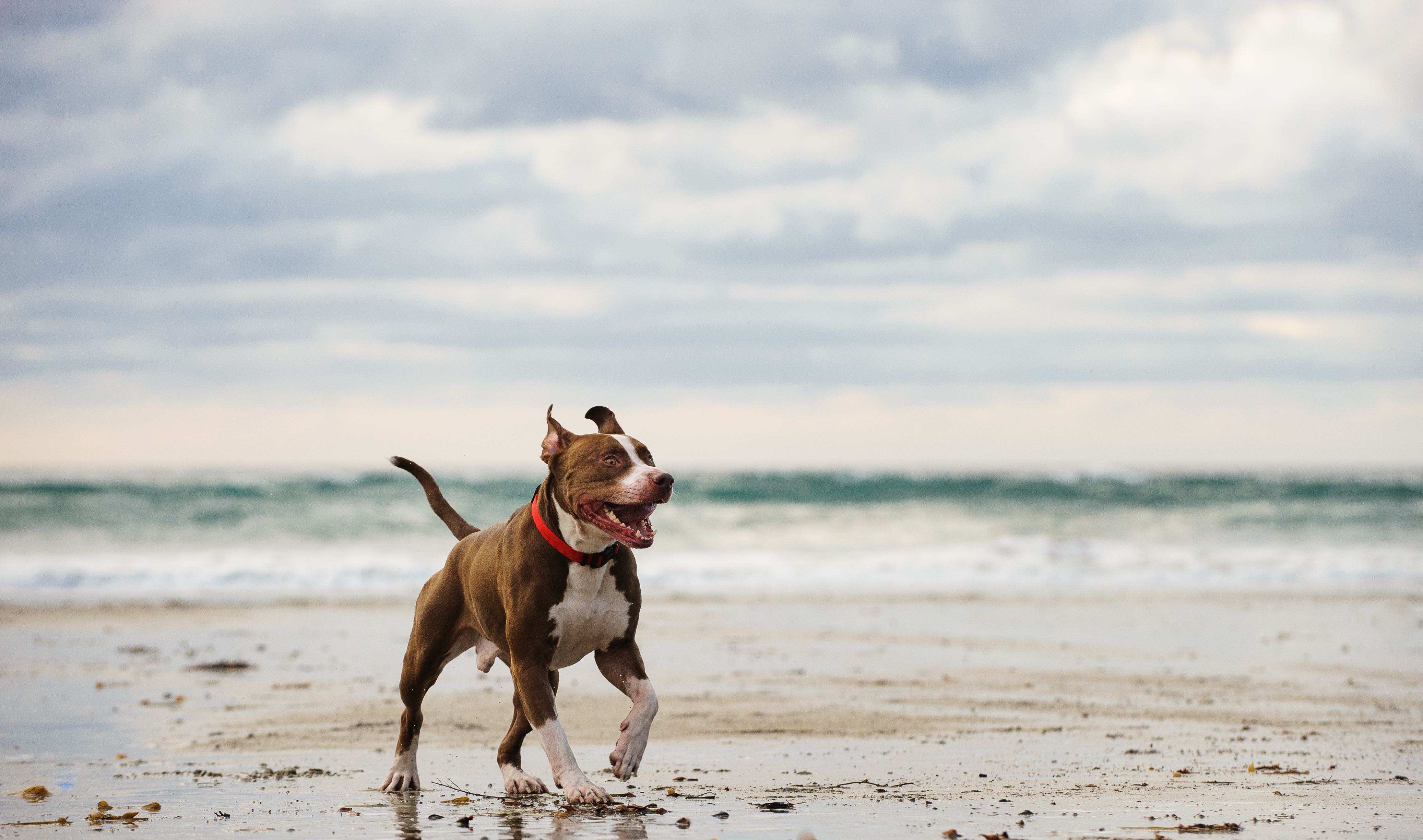
Choosing the right food for your Pit Bull is important for their health and well-being. When selecting dog food, look for a high-quality, balanced diet that is appropriate for their life stage and activity level, and approved by the Association of American Feed Control Officials (AAFCO). Pit Bulls tend to gain weight easily, so choose a food low in fat and calories that provides adequate protein to support their muscular build.
Consult with your veterinarian when choosing food for your Pit Bull, as vets can provide personalized recommendations based on your dog’s age, health, nutritional needs, and pre-existing conditions.
How To Feed a Pit Bull
Most adult Pit Bulls do well on two meals a day: one in the morning and one in the evening. Pit Bull puppies and senior dogs may benefit from smaller, more frequent feedings on a regular schedule. Because of their powerful jaws, Pit Bulls may benefit from using heavy-duty stainless steel or ceramic feeding bowls to prevent them from chewing or damaging plastic bowls.
How Much Should You Feed a Pit Bull?
Determining the right amount of food for a Pit Bull can be a bit of a balancing act, as the breed’s energy level, activity level, age, and overall health can all play a role. Most dog food packaging will include recommended feeding amounts, based on the dog’s weight, to help you find the correct amount.
Still, some adjustments may be needed. Monitor your Pit Bull’s body condition, and adjust their food intake as needed to maintain a healthy weight. A healthy Pit Bull Terrier is lean and muscular, with a noticeable waist and ribs that can be felt but not seen. If you notice your Pit Bull gaining or losing weight, adjust the amount of food accordingly.
Regular visits to the veterinarian can help ensure that your Pit Bull is receiving a balanced and nutritious diet throughout their life.
Nutritional Tips for Pit Bulls
Supplements can be helpful for a Pit Bull’s diet, but they should never be used as a substitute for a balanced, complete diet. Pit Bull Terriers might benefit from:
-
Joint supplements: Pit Bulls are prone to joint problems such as hip dysplasia, so supplementing their diet with glucosamine and chondroitin can help support joint health and reduce inflammation.
-
Omega-3 fatty acids: These can help support skin, coat, and overall immune health in Pit Bulls. They can also help reduce inflammation and improve skin health.
-
Vitamin E: This vitamin is a powerful antioxidant that can help protect cells from damage and support the immune system. It’s also important for skin and coat health, and it can help reduce the risk of certain health conditions, such as cataracts.
-
Probiotics: These help support digestive health and improve gut health, which is important for overall wellness in Pit Bulls.
Behavior and Training Tips for Pit Bulls
Pit Bull Personality and Temperament
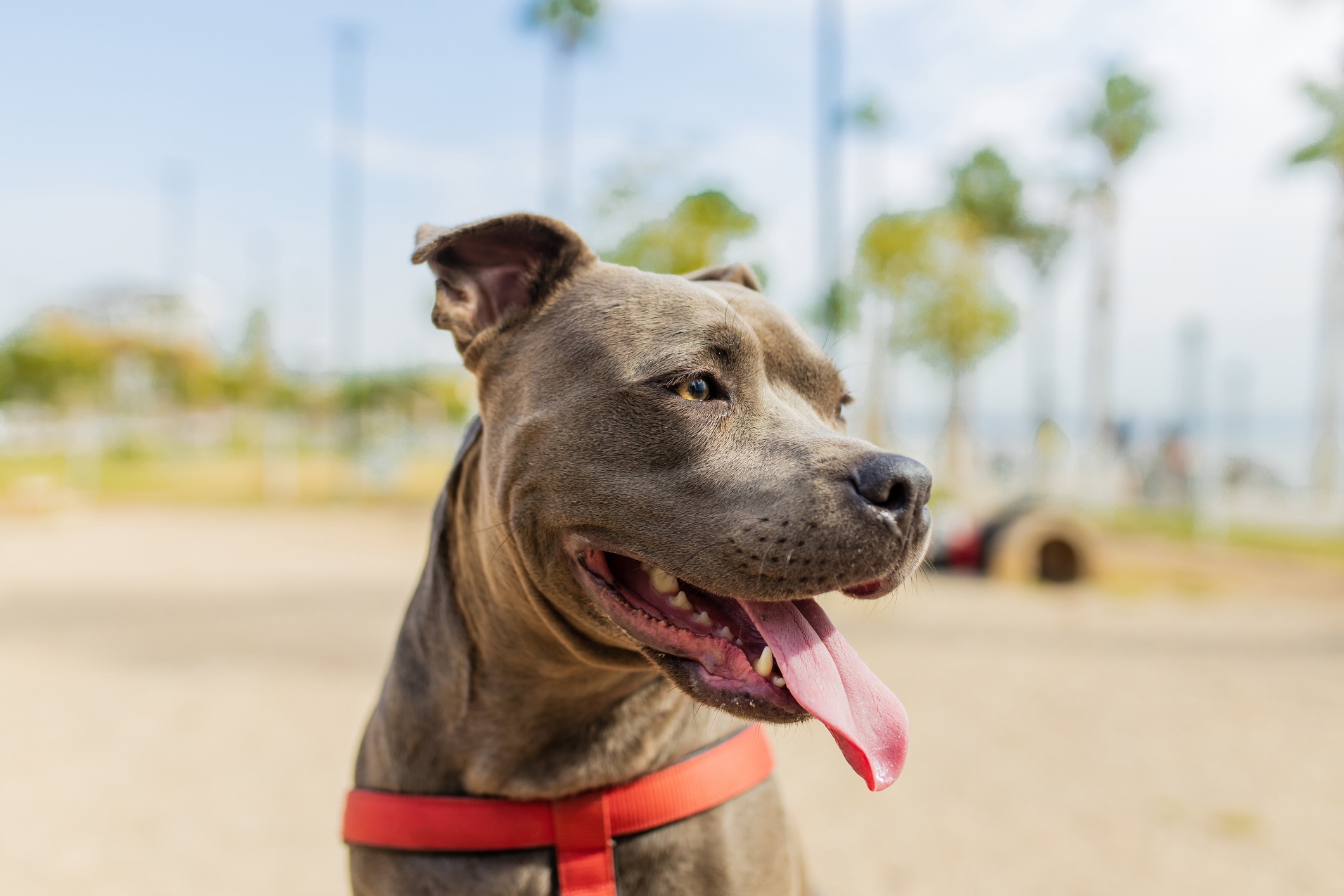
American Pit Bull Terriers have a friendly and outgoing temperament but can still be quite strong-willed. With their high energy and intelligence, pet parents should be prepared to put extra effort into keeping their Pit Bull entertained, well-exercised, and mentally stimulated.
Well-trained and socialized Pit Bulls are often good with children and other pets, but it’s important to supervise interactions between kids and dogs, no matter the breed. Pit Bulls are often described as “Velcro dogs” due to their strong bond with their pet parents and desire to always be near them. This always-at-your-side characteristic can make them especially fun for older children who are excited to have a constant companion.
Pit Bull Behavior
Pit Bulls can be prone to anxiety, especially if they don’t receive the socialization, exercise, and mental stimulation they crave. Because this breed is so focused on their favorite people, time spent alone can lead to separation anxiety. They aren’t a breed that does well when left by themselves all day.
As curious and adventurous dogs, Pit Bulls can sometimes get into trouble. They may be inclined to explore their surroundings and can wander away from home if not properly supervised. Always keep your pup on a leash or inside a fenced-in yard.
Pit Bull Training
Pit Bulls are generally friendly, loyal, and eager to please, which makes them responsive to positive reinforcement training methods. However, if training gets stale or isn’t challenging enough for this intelligent breed, you may start to see their independent side.
Reward your American Pit Bull Terrier with praise, treats, and affection. This type of training encourages good behavior, and reinforces the bond between dog and human. Consistency is also important to any successful training, and this breed does best with a routine, established rules, and boundaries.
With their high energy and intelligence, pet parents should be prepared to put extra effort into keeping their Pit Bull entertained, well-exercised, and mentally stimulated.
Fun Activities for Pit Bulls
-
Agility
-
Nose work
-
Frisbee
-
Obedience training
Pit Bull Grooming Guide
Pit Bulls have a short, dense coat that is smooth and shiny. They are generally considered low maintenance when it comes to grooming, as their short hair does not require frequent trimming or professional grooming.
However, Pit Bulls are known to shed moderately throughout the year, with heavier shedding during the spring and fall. To control their flying fur, brush them regularly with a slicker brush or a rubber grooming tool. Not only will this help remove loose hair, but it will also distribute skin oils and keep their coat looking healthy.
Skin Care
Pit Bulls generally do not require special skin care, and their short, thick coat provides natural protection for their skin. However, like all dogs, Pit Bulls can develop skin irritations or infections if they come into contact with irritants such as grass, chemicals, or parasites. If you notice excessive licking, redness, swelling, or flaking skin, contact your veterinarian for an exam.
Coat Care
While Pit Bulls don’t need as much grooming as other, longer-haired breeds, they should be brushed regularly to remove loose hair and dirt. Brushing your dog once a week or every two weeks should be fine, but you can increase the frequency if your Pit Bull sheds a lot.
Pit Bulls do not need frequent baths, but you can bathe them as needed to keep them clean. When you do bathe your Pit Bull, use a gentle, dog-specific shampoo, and avoid getting soap or water in their eyes, ears, and nose.
Eye Care
Some Pit Bulls are prone to tear stains: dark, rust-colored marks on the fur under the eyes. To prevent tear stains, keep the area under the eyes clean and dry with a cloth or dog-safe eye wipe.
Ear Care
Pit Bulls, like many breeds with floppy ears, can develop ear infections due to the overgrowth of bacteria and yeast in the warm, moist ear canal.
Routine ear cleaning is important to remove the dirt, wax, and debris that can build up. Use a cotton ball or soft cloth moistened with a gentle, vet-approved cleaning solution to wipe the inside of the ear flap. Avoid using cotton swabs, as these can damage the canal’s delicate skin and tissues.
Regularly inspect your Pit Bull’s ears for redness, swelling, discharge, and odor, which can indicate an ear infection. If you notice any of these symptoms, take your pup to the vet for an evaluation.
Considerations for Pet Parents
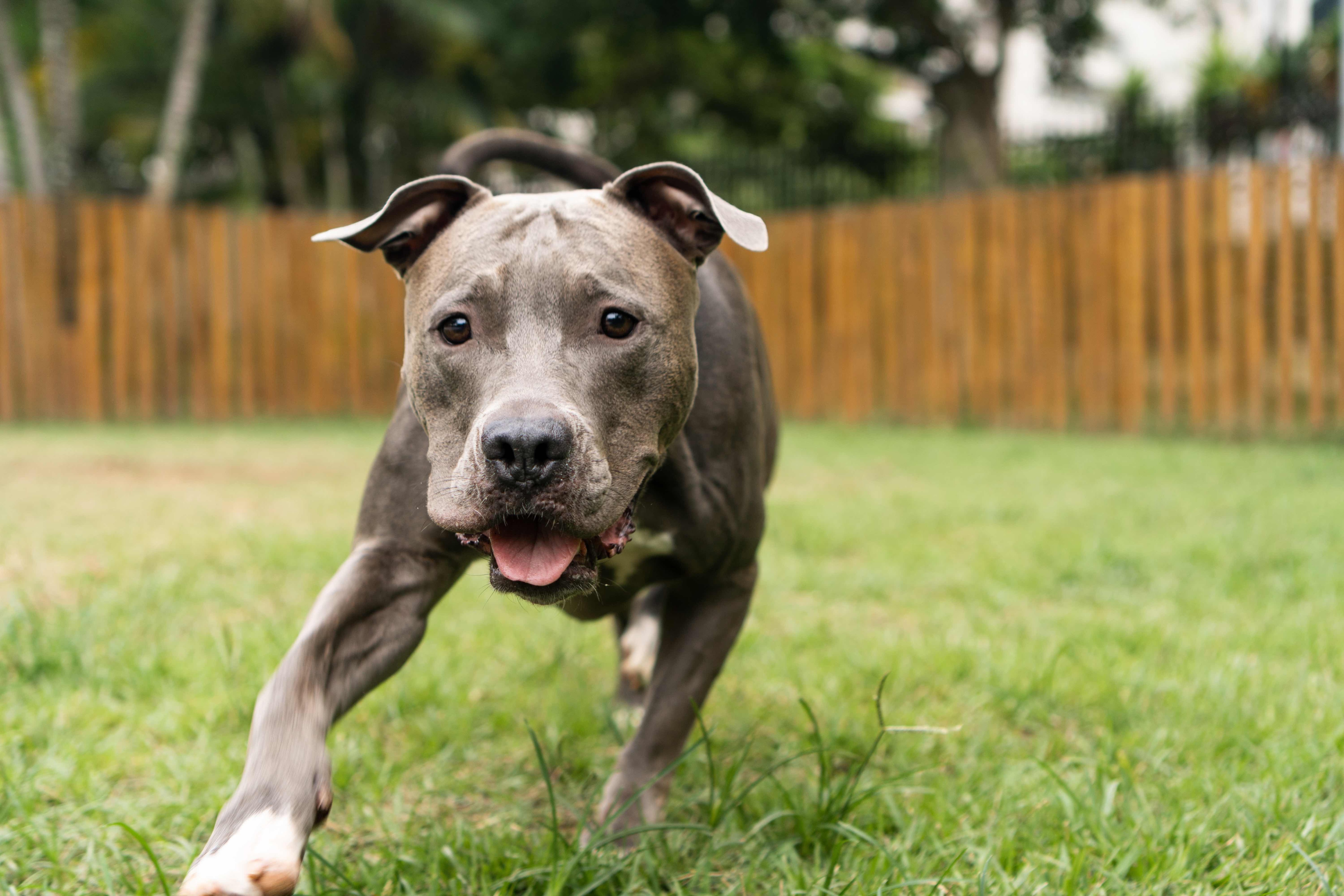
The perfect home for a Pit Bull is one with an active family who enjoys spending time outdoors, as high-energy Pit Bulls love to play and exercise.
Potential pet parents should be ready to devote time and attention to training, socialization, and exercise, as American Pit Bull Terriers can be strong-willed and require consistent positive reinforcement. These dogs can become easily overexcited and may need help learning how to behave in new situations.
Because Pit Bulls are big, energetic dogs, they might do best in a home without small children, as they can be too exuberant and may unintentionally knock over smaller kids. But with proper care, training, socialization, and attention, a Pit Bull can make a loving, loyal, and entertaining companion.
Pit Bull FAQs
Is the Pit Bull a dog breed?
The term “Pit Bull” actually refers to a collection of breeds, including American Staffordshire Terriers, Staffordshire Bull Terriers, American Bulldogs, Bull Terriers, and mixes of these dogs. That said, the dogs under this umbrella term share many similar characteristics.
What was the Pit Bull bred for?
The American Pit Bull Terrier was originally bred in England in the 19th century for bull baiting, a popular blood sport in which dogs were used to bait and fight bulls. They were later brought to the U.S., where they were used for hunting and as working dogs on farms.
What do Pit Bulls weigh?
American Pit Bull Terriers typically weigh 30–75 pounds, with males typically weighing more than females. The weight of an individual dog can vary greatly depending on genetics, diet, and overall health.
Is an American Pit Bull Terrier a good family dog?
Yes, an American Pit Bull Terrier can make a good family dog when raised and trained properly. They are known for their loyalty and affectionate nature but, like any dog breed, they can exhibit problematic behaviors if they don’t receive enough socialization, exercise, and mental stimulation. Proper training, early socialization, and a committed parent can help ensure that a Pit Bull is a happy and well-behaved member of the family.
Featured Image: iStock/Diego Thomazini
Help us make PetMD better
Was this article helpful?
